I am an educator who firmly believes in and supports the use of Universal Design for Learning (UDL) in the classroom. One example of its implementation was in my Grade 7 in-person language arts class, which included 26 students with diverse learning needs. Among my students were individuals with visual impairments, various learning disabilities, and behavioral disorders. Given this complexity, it was crucial to intentionally design my classroom using UDL principles to enhance student engagement and learning.
Key elements included offering students a choice in testing options, such as audio tests or oral responses instead of written ones. Additionally, I created different learning centers to cater to various preferences, including a quiet corner, a discussion area, a helper station, and a teacher station. I also integrated technology, providing access to digital tools like text-to-speech software and interactive reading apps to support different learning styles.
To further support diverse learners, I incorporated multimedia resources, such as videos with closed captions and interactive storytelling tools, which helped make content more accessible. For my higher achieving students, I used technology to act as an editor as they worked independently on writing short stories for publication. In addition, I did not have a seating plan thus allowing students to choose where they felt most comfortable and promoting choice, and responsibility, in their learning. Collaborative group work was encouraged, with roles assigned based on individual strengths, fostering peer support and engagement.
Regular check-ins and formative assessments helped me tailor instruction to meet individual needs, while goal-setting activities empowered students to take ownership of their learning. By embracing UDL, I created a more inclusive and supportive learning environment, ensuring that every student had the opportunity to succeed and thrive.

Hi Hannah,
This is a great example of UDL principles in action. The first thing that stood out for me—beyond your commitment to UDL in your practice—was your transformative creation of dedicated physical spaces to serve a variety of needs. I think that too often classrooms are merely holding pens, with the expectation that students will fill them in the traditional, rigid, and mono-directional manner; we all know this does not work for everyone.
I also appreciated that when you incorporated technology, you did so with a diversity of student experience in mind. It serves as a reminder that specific accessibility interventions often require a bit of simple planning—in your case, aptitude-based task switching—in order to provide the most benefit to all.
Lastly, I liked the straightforward accountability measures you put in place to ensure the UDL concepts were appropriate not just to individual students, but the class community as a whole.
Cheers,
Jeremy